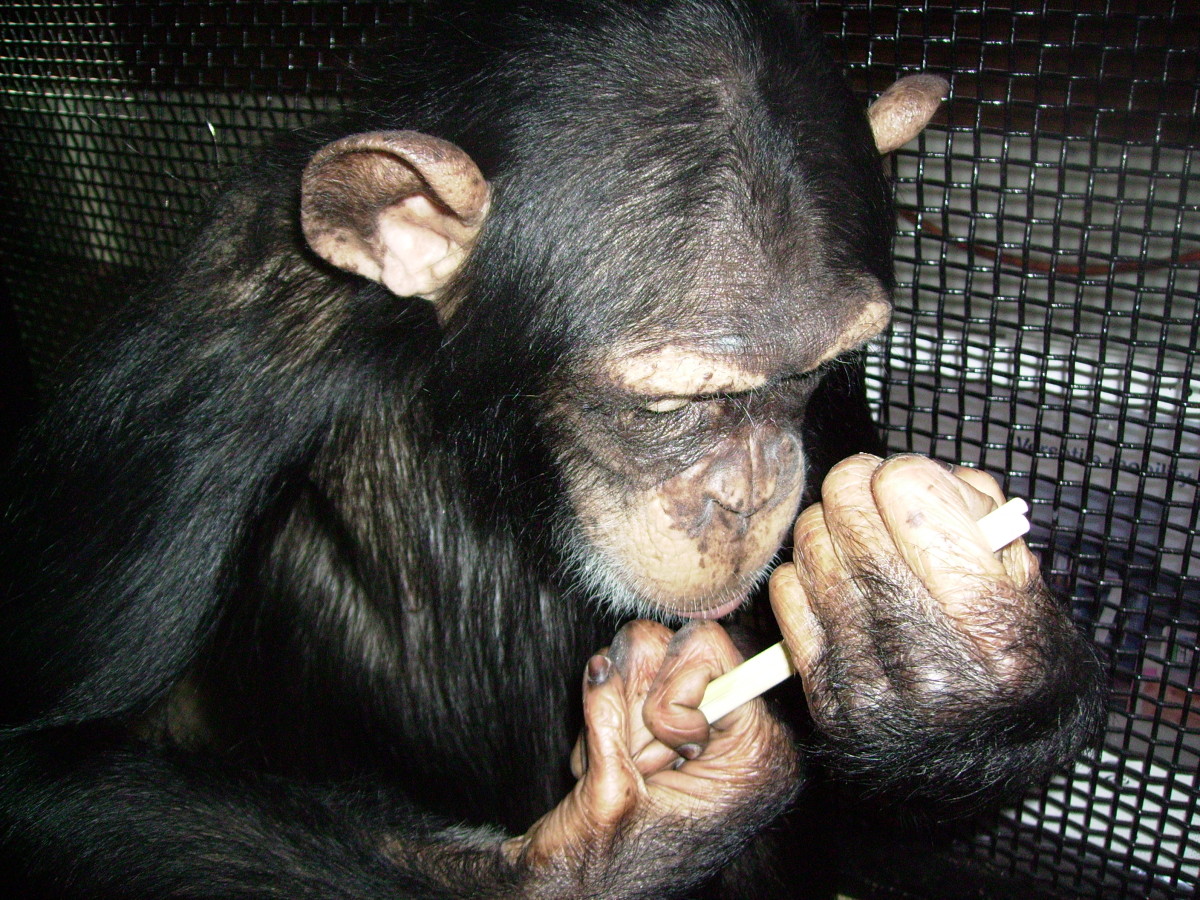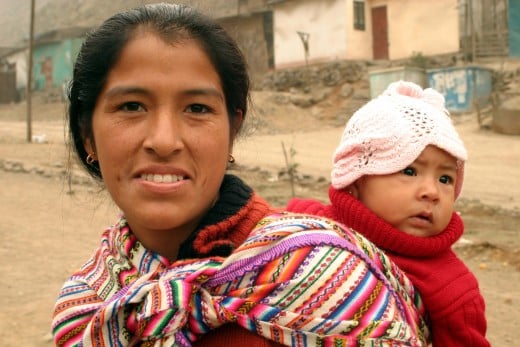This past Friday, I reviewed the YouTube Channel called “Thinking-Ape.” In doing so, I dredged up a few of my old articles on Neoteny, Dominance and Women’s Suffrage in New Jersey.
My Old Neoteny Article
Developmental Delay as the Primary Cause of the Unusual Material Culture Among Humans
Updated on December 14, 2010

What makes human beings unique among all the creatures of the earth? It sounds like almost a biblical question. But did you know that many in the scientific community are still asking that question? This query has built into it a very big assumption: that we are somehow more “special” than any other animal. Are we? What are they basing that on?
We are not the only animal that builds things. We are not the only animal that uses tools, or even that uses other tools to make tools. We are not the only animal with a communication system. We are not the only animal to compose music. We are not the only animal that thinks.
When it comes right down to it, there is nothing that anybody can point to to suggest that we are all that different from other animals, besides the all-prevasive material culture that humans are known for.
So why is it that, even though we are not the only animal on the planet to build and make things, we do seem to be the only one to build and make things that are not easily biodegradable and that therefore outlast not just the individuals who built them, but the entire civilizations from which they arose? This, I think, is a question worth addressing.
Neoteny in non-humans and in humans: A Permanent Developmental Delay
What is developmental delay and why do I think it is responsible for our unusual fixation on the permanence of material objects that we have made? Isn’t the term “developmental delay” just a new phrase to replace the politically incorrect “mental retardation”? Isn’t someone who is developmentally delayed essentially a moron?
Well, no! But thanks for asking. The word “moron” is a technical term to describe a person with an unusually low IQ. “Mental retardation”, when the term was first introduced, was meant to refer not to a person’s absolute intelligence, but to the relative degree to which their mental abilities are behind the average developmental level for their age group. So a “mentally retarded” person at three years of age may just be behind others in that age group, and may later catch up with and even surpass others.
Unlike mental retardation, “developmental delay” refers to all kinds of abilities and skills, not merely what we narrowly term intelligence. It can include motor skills, balance, the ability to stand on our own two feet, to survey the scene and draw conclusions about a situation and to respond non-verbally to social cues and any number of other skills not measured in an IQ test.
The fact of the matter is that all human beings, even the most “normal”, are developmentally delayed at birth compared to most other mammals of the same age. Not only that, but if you really look closely, most of us never catch up. We are never as graceful as a gazelle, and we are never as self-sufficient as a wolf, and even the most wily politician among us does not have the innate social skills of the average chimpanzee for forming coalitions in a peer group. We are slow to learn and slow to automate the skills that we have learned.
Humans suffer from extreme neoteny. This means that even when we are adults, we look and behave much like juveniles. We never really grow up, and as a result we continue to learn throughout life, and we continue to play with toys long after that stage of development is outgrown in other species.
Black Bear Mother Keeps Playing Cubs Safe
Mammalian Developmental Delay: The Invention of Childhood
In order not to single humans out unduly, let’s keep in mind that mammals and birds are already somewhat developmentally delayed compared to most fish, reptiles and amphibians. While reptiles and fish and the other life forms that resemble them are not usually involved in caring for young, birds and mammals dedicate a portion of their life to provisioning helpless, underdeveloped and developmentally delayed offspring.
The downside of this arrangement is that adults are burdened with the care of parasitic young. The upside is that since the young are not prewired to know everything they need to know at birth, there is room for learning from experience, and birds and mammals have the opportunity to develop their intelligence throughout their childhood.
The prototypical mamalian child has a big head and a small body, engages in activities that serve no useful purpose (otherwise known as play), and is full of curiosity about the world and how it works.
By the time a typical mammal arrives at adulthood, there is much less play, and a serious interest in staying alive, getting food, procreating and caring for young pushes aside the pastimes of infancy and childhood.
In order to survive, an adult has to live in the moment and to consider those things that threaten survival. Anything beyond is a luxury reserved to growing children.
Comparison between Chimpanzees and Humans
Humans and chimpanzees are very closely related. The retarded maturation in both species is quite pronounced compared to that of many other mammals. Chimpanzee young, like the children of hunter-gatherer humans, are carried about by their mothers and suckled for the first three years of life, and are often still being carried until they are five years of age. They do not enter puberty until sometime between eight and ten years of age, and even then they are not fully mature and do not become adults until their late teens. In the wild, a chimpanzee lives to be about forty, which is similar to the human survival under natural conditions without modern comforts. In captivitiy chimpanzees can live to be seventy-five or older.
However, despite these similarities, development in humans is even more delayed than in chimpanzees. A chimpanzee can support its full weight at birth. Carried by the mother, it clings with its strong arms to her hair. Social awareness and sense of balance develop months sooner in a chimpanzee than in a human.
Compared to a chimpanzee, a human child, even the most normally developing one, appears a little bit autistic. Physical coordination as well as social development are considerably delayed in humans, behind the normal timetable for chimpanzee maturation.
When Sword Met Bow
Sword and Bow play with blocks (2007)
Constructive versus destructive play
If you have raised both a chimpanzee and a human child, as I have, then you notice also that while both like to play, the human child becomes interested in putting things together and building things, and saving things for later, while the chimpanzee child enjoys taking things apart, playing with them roughly until they are entirely consumed and no longer exist, and using found objects as projectiles and weapons.
Of course, that might also be the difference between a girl and a boy. I have such a small sampling, it’s hard to draw definitive conclusions.
In any event, from what we have seen chimpanzees do in the wild, while they can and do use objects as tools, create new tools, and do any number of very inventive things, what they do not seem to do is to keep the same material objects in good condition over a considerable period of time. They build nests and they abandon them. They adorn themselves momentarily, but they throw the object away. They make tools and they do not keep them.
Ownership is not a big thing. Material goods, besides comestibles, are not valued or prized. Interest in any object is of short duration, for its usefulness, but not as a keepsake. Why?
Some people say chimpanzees don’t have material culture because they don’t have language. I don’t believe that for two reasons: there is no evidence that they don’t have a language of their own. When we teach them one of our languages, they learn it. They can spell. They can speak grammatically. But they still destroy material objects and cannot be bribed with money or toys.
Even if you don’t believe the claims that chimpanzees and bonobos can use language, let’s look at it from the opposite direction. We know that all human population groups have a language. But do all humans have a rich material culture? Do all humans engage in commerce? Do all humans even know how to count?
It’s hard to get a chimp not to break a chopstick, even though it means he’ll have one chopstick less

The Requirement for Direct and Immediate Evidence
The Pirahã people
The Pirahã people are indigenous to Brazil. They are a hunter-gatherer people, and in their language there are no numbers. There are no ordinal numbers, and there are no cardinal numbers. And when researchers asked adult members of the Pirahã people to participate in a study on numerosity (the ability to estimate numbers) they were not able, even by writing lines on a piece of paper, to tell the researchers how many objects were placed before them.
Some researchers have claimed that the Pirahã people are incapable of counting. I tend to agree with Professor Daniel L. Everett when he says that they are cognitively capable of counting, but have no interest in doing so.
In a New Yorker article by John Colapinto, an eleven year old Pirahã boy is described making a model airplane out of balsa in response to the arrival of an airplane, but the model is soon broken and discarded. It’s not that the Pirahã can’t make things or that they are not intelligent, it’s just that they do not value the things they make, and so they don’t accumulate material goods and they do not build a material culture.
The Pirahã adults are fully adult in the same sense that a black she-bear caring for her cubs is an adult. They know what matters is the present and the immediate future, and they can’t be bothered expending much energy on flights of fancy.
Yes, there are many animals in the jungle, many fish in the river, many stars in the sky. Possibly there is some way to quantify that, but why bother?
Developmental Delay as a Cultural Artefact
Some forms of developmental delay are induced by environment. For instance, the middle class child is intentionally delayed in maturation by being kept in school and not allowed to learn a trade. The lower class child, in societies that still permit a lower class to exist, on the other hand, is allowed to mature sooner, and begins to earn his keep earlier. Neoteny takes makes many forms, and not every one of them is genetic.
Tell a child that reading is more important than going fishing, and the child will delay his maturation as a fisherman. Teach an infant that letters are more important than social contact, and he may grow to be hyperlexic. Compliment someone on his intellectual skills and ignore his social growth and it will eventually have some sort of effect. Between the natural selection in favor of certain traits that our culture promotes in the mating game, and the fostering of behaviors within the family and society, it is all heading in one direction.
In industrialized societies today, many more children are experiencing developmental delay of an extreme form that has been labeled autism. We don’t know the cause, but one thing is obvious: it’s a continuation of the same trajectory that separates mammals from reptiles, human beings from the other great apes, and industrialized humans from their hunter-gatherer contemporaries.
So, the next time someone asks: why do we have a material culture, whereas they don’t, you might answer: maybe it’s because they don’t want one. Maybe they just don’t think it serves any useful purpose..
Copyright 2010 Aya Katz
When Sword Met Bow
Related Hubs and Links
- http://www.bioscienceresource.org/commentaries/article.php?id=46
- Pirah people – Wikipedia, the free encyclopedia
- Facts about Homo Sapiens that You May Not Already Know
Perhaps you are considering adding another human being to your household. Or maybe you have no experience at all with human beings, and this will be the first one you encounter. This hub will give you some… - The Progress of Mankind – In the Beginning was the Word
Three questions that have exercised thinking minds for a very long time are: How did the Universe begin? How did life on Earth begin? What makes Human
My Old Dominance Article
What is Dominance
Updated on June 13, 2016

There’s been a lot of talk about dominance on Hubpages lately. Some people say that it behooves a married woman to allow her husband to be dominant. This strikes me as odd, because if he is dominant, why does he need anyone to allow him to do anything? If he’s not dominant, then how in the world can somebody else make him dominant?
What it comes down to is a very strange usage of the word dominance. I propose that before we get into a heated argument about who necessarily needs to be dominant in any given relationship, we should first of all agree on what dominance actually means.
Who is dominant in this picture?

Definition of Dominance
Dominance is having control, power or governance over a situation. When individuals are together in a relationship, the ones who cast the decisive vote as to what should happen among them are the more dominant parties. Dominance is not about exchanging material goods. It is about decision making powers.
For instance, in the mother/infant relationship, the mother is normally dominant, until the child attains independence. Even though the mother serves the infant, and more goods and services flow from the mother to the infant than from the infant to the mother, the mother gets to decide what happens between them. The infant starts out as virtually helpless.
Dominance is not about who gets more. Dominance is not about what happens between people. It is about who decides what will happen.
Dominance versus Deference

Dominance and Chivalry Among Bonobos
If you are confused about this issue, don’t feel bad about it. Many primatologists are equally confused. For instance, there have been reports that in bonobo society females are dominant. These claims were in part based on observations of food sharing behavior. When bonobos were provisioned with sugar cane, the females and their young were seen taking their share first, and then, only when they had finished, did the males go in to take what was left.
The primatologists observing this at first assumed that taking food was what everyone wanted to do, and that if the males had to wait till the females finished, the females must be dominant. But then it was observed that it was the older males who enforced this rule among the younger, less powerful males. Young, inexperienced males were castigated by older, more powerful males for trying to cut in before the females had finished.
What the primatologists had witnessed was an example of chivalry. The males were dominant, and they used their dominance to protect and show deference to the females and their young. They understood that if the males took everything they could, there would be none left for the females and their young.
Joan of Arc at the coronation of Charles VII

Queen Elizabeth I with her Rod and Scepter

Social Rank and Individual Dominance Are Not Always the Same
In human societies, explicit formal ranking sometimes replaces actual dominance. This means that a person is placed in charge of a situation, even though another person on the scene is more intrinsically dominant. Sometimes a commanding officer is less charismatic or brave or strategically brilliant than one of the soldiers he commands. Sometimes a student knows more than a teacher. Sometimes one party is the nominal head of the family, while another family member really dominates the scene.
So it happens that even though someone is younger, less experienced than another, or less educated, the better person for the job comes to dominate the situation naturally, based on personal characteristics. What should the naturally dominant person do, when he is outranked formally?
This depends. In times of peace, when nothing much is at stake, showing deference to a less able commanding officer may be the right thing to do. However, in the thick of battle, it might really matter what decision is made, and at times the naturally dominant person will have to stand up to the one who outranks him, for the sake of everybody.
All things being equal, adults usually outrank children, better educated people outrank those with less education, and men tend to be better warriors and hunters than women. However, real dominance is not a matter of statistics. It is about what happens when individuals meet and interact. Sometimes quite unexpectedly, a person with lesser social rank can come to be dominant. An unlettered peasant woman can lead an army. A little child can out-think his masters. And a queen can not merely reign, but rule.
Meet John Doe: Who is dominant in this scene?
Sometimes it is not completely obvious who dominates
Because truly dominant individuals tend to show deference to those whom they dominate, it is not always easy to tell at first glance who is dominant in any given situation. Watch the clip I’ve embedded above of the scene from Meet John Doe. In this scene, Barbara Stanwyck plays a very strong and determined woman who socially outranks the character played by Gary Cooper. But who is really dominant? If you have any thoughts about this, leave me a note in the comment section!
I work and live with an eight and a half year old male chimpanzee named Bow. I am his adoptive mother, and I socially outrank him. However, he gets his way an amazing percentage of the time. When I want him to do something, I have to ask nicely, or it doesn’t get done. Do I dominate Bow or does he dominate me? I’m not sure. It’s a close call.
Who is dominant?


Dominance in Marriage
What about dominance in marriage? I can’t say from personal experience, but from observing other people’s marriages, I would say that it varies. It depends on the individuals involved. Is he a stronger person? Is she? The dynamic can even vary between different stages of the same marriage.
But what is ideal? Well, ideal is whichever way you like it! But even here, dominance is not something the parties can agree upon. It’s something that happens based on who they are as individuals. Like love, dominance can’t be faked.
Ayn Rand very much wanted to be in a relationship with a man who would play the dominant role both in the bedroom and elsewhere. However, she was a very strong woman, and all the men she met were weaker. She married Frank O’Connor, and she tried very hard to play the submissive wife, but it didn’t work, because nobody can give another person dominance. You either have it or you don’t.
A woman can pretend all she wants that her husband is dominant, but it’s really not up to her. The most she can do is to show deference. That’s all anybody can do.
(c) 2010 Aya Katz
Here is the link to the article on Women’s Suffrage:
https://theodosiaandthepirates.blogspot.com/2014/08/universal-suffrage-for-free-people-in.html
RELATED LINKS
https://theodosiaandthepirates.blogspot.com/2014/07/property-rights-education-and-suffrage.html
